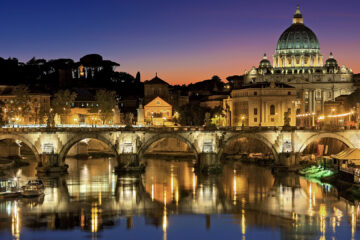
Istanbul: Convergence of Continents and Cultures
For over 2000 years, Istanbul was a glorious metropolis that received, pleased and sheltered the Greeks, Romans, Turks, Christians and Muslims and their heritages. Nestled at the crossroads of continents, Istanbul speaks of cultural legacies, echoing through its ancient streets and vibrant bazaars. Here, the whispers of emperors and sultans linger in the air, intertwining with the calls of muezzins and church bells, creating a symphony that resonates with the diversity and complexity of human history. More than just a geographic marvel, this city is a living chronicle of a ceaseless journey through ages and empires.
The Founding of Byzantium
Around 660 BCE, Greek colonists from Megara, led by the legendary King Byzas, ventured across the Aegean Sea, seeking new lands. Guided by the Oracle of Delphi, they settled on the European side of the Bosporus Strait, founding Byzantium. This site was chosen for its strategic significance; it was where Europe met Asia. The city’s natural harbour, the Golden Horn, offered a perfect maritime inlet shielded from storms and enemies. At the same time, its position on the Bosporus ensured control over the naval passage between the Black Sea and the Mediterranean.
The Greek Influence and Rise of Byzantium
With their characteristic acumen for trade and navigation, the Greeks swiftly capitalized on Byzantium’s geographical advantages. The city became a bustling trading hub, markets a cacophony of languages and a mosaic of goods from distant lands. Over centuries, Byzantium grew in wealth and prominence, attracting not just merchants but also the attention of powerful empires.
The Roman Era and the Birth of Constantinople
The turning point in Byzantium’s history came with the Roman Emperor Constantine the Great. In 330 CE, he recognized the city’s unparalleled strategic and economic potential and declared it the new capital of the Roman Empire, renaming it Constantinople. This decision marked the beginning of the city’s transformation into a monumental metropolis. Under Roman influence, Constantinople flourished, adorned with grandiose architecture like the Hagia Sophia, a testament to its newfound status as the heart of the Eastern Roman, or Byzantine Empire that prospered growing its borders for over 1000 years.
The Byzantine Epoch and Cultural Flourishing
Constantinople emerged as a bastion of Christianity and a centre of Hellenistic culture. Its formidable defensive walls repelled countless sieges, constructed to ward off invaders, symbolized the city’s strength and resilience. The Byzantines, heirs to both Greek and Roman legacies, cultivated a sophisticated urban culture. Art, theology, and philosophy thrived, and Constantinople’s libraries and schools became the envy of the medieval world.
Early Sieges and Attacks
Constantinople faced its first significant siege in 626 CE when the combined forces of the Avars, Slavs, and Persians encircled the city. The Byzantines, under the leadership of Patriarch Sergius and Emperor Heraclius, successfully repelled this attack through a combination of robust defences and strategic diplomacy. This siege set the precedent for Constantinople’s seemingly invincible status.
Arab Sieges
The rise of the Arab Caliphates in the 7th and 8th centuries brought a new wave of threats to Constantinople. The city withstood two major Arab sieges in 674-678 CE and 717-718 CE. The first siege saw the Byzantines employ Greek fire, a fearsome incendiary weapon, to devastating effect against the Arab fleet. The second siege, led by the Umayyad Caliphate, ended in a disastrous defeat for the besiegers, largely due to harsh winter conditions and the indomitable city defences.
The Russian Threats
Throughout the 9th and 10th centuries, Constantinople faced several attacks from the Russians, who sailed down from what is now Russia and Ukraine. These attacks, while formidable, were consistently thwarted by the city’s defences and its strategic use of Greek fire. The Treaty of 907 between the Byzantines and the Russians marked a turning point, leading to a period of relative peace and trade agreements.
The Crusader Attack: A Close Call
One of the most significant threats to Constantinople came not from the traditional eastern enemies but from the Fourth Crusade in 1204 CE. Originally intent on reclaiming the Holy Land, the Crusaders diverted to Constantinople due to a complex web of political and economic motivations. Although they successfully breached the city’s defences and sacked it, this was not a straightforward military defeat but a result of internal treachery and external manipulation.
The Bulgar and Serb Incursions
Throughout its history, Constantinople also faced intermittent threats from its northern neighbours, the Bulgars and the Serbs. While these incursions never reached the catastrophic levels of the Arab sieges or the Crusader attack, they added to the constant state of vigilance that the city had to maintain.
The Fall of Constantinople
Despite the numerous threats and attacks, the city’s fortunes were to take a dramatic turn. In 1453 CE, Constantinople fell to the Ottoman Turks under Sultan Mehmed II after a prolonged siege. Renamed Istanbul, it became the heart of the Ottoman Empire, a powerful Islamic caliphate that straddled three continents. The city flourished as an epicentre of trade, connecting the Silk Road with Europe. The architectural genius of Mimar Sinan and the cultural patronage of successive sultans adorned Istanbul with mosques, baths, and bazaars, creating a skyline that blended Byzantine and Islamic influences seamlessly.
Decline of the Ottoman Empire
The decline of the Ottoman Empire, with its heart in Istanbul, was a protracted and complex process marked by internal strife, external pressures, and a gradual erosion of power. This period, unfolding over centuries, saw the once-mighty empire scuffle with challenges both at home and abroad, leading to its eventual dissolution in the early 20th century.
The Seeds of Decline: Loss of Military Dominance
The beginning of the Ottoman decline can be traced back to the 17th century, when the empire’s military prowess, once the terror of Europe, started to wane. The failed Siege of Vienna in 1683 was a turning point, marking the end of Ottoman territorial expansion in Europe. This setback was symptomatic of deeper issues within the Ottoman military structure, including outdated tactics and a lack of technological advancement, which increasingly lagged behind European powers.
Administrative and Economic Troubles
The administrative system of the empire, once efficient and innovative, began to show signs of decay. The devshirme system, which had supplied the kingdom with talented administrators and fierce Janissaries, became corrupt and ineffective. Economic difficulties further exacerbated the empire’s woes. Trade routes that had once enriched the Ottomans were shifting, and the empire became increasingly sidelined in a world moving towards global maritime trade dominated by European powers.
Internal Dissent and Nationalist Movements
The 19th century saw the rise of nationalist movements within the diverse ethnic and religious groups under Ottoman rule. The Greek War of Independence (1821-1829) was a significant blow, leading to the loss of Greece, a region of both strategic and cultural importance to the empire. This uprising ignited a chain reaction of nationalist movements, gradually eroding the Ottoman hold over its Balkan territories.
The “Sick Man of Europe”
By the 19th century, the Ottoman Empire was widely called the “Sick Man of Europe,” a term emblematic of its diminishing power and prestige. Efforts to modernize the empire, known as the Tanzimat reforms, were implemented to revitalize the ailing state. Though well-intentioned, these reforms were met with mixed results, often hampered by conservative factions within the empire and the deep-seated structural problems they sought to address.
The Final Blow: World War I and Aftermath
The empire’s entry into World War I on the side of the Central Powers was the final blow to its survival. Devastating losses and economic ruin followed, and by the end of the war, the once-great empire was carved up by the victorious Allied powers. The signing of the Treaty of Sèvres in 1920 CE and later the Treaty of Lausanne in 1923 CE marked the formal end of the Ottoman Empire, giving birth to the modern Republic of Turkey with its capital in Ankara, effectively shifting the political centre away from Istanbul.
The decline of the Ottoman rulers in Istanbul was not just the fall of a dynasty but the end of an era that had shaped the course of world history for centuries. Once the epicentre of a vast empire, Istanbul transitioned into a city reflecting the grandeur of its past and the realities of a new, modern Turkey. The slow decline of the Ottoman Empire is a poignant reminder of the impermanence of power and the relentless march of time, leaving behind a city with its glorious and turbulent history.
The Legacy of the Greeks and Istanbul Today
The Greek settlers who founded Byzantium could scarcely have imagined the enduring impact of their settlement. The city they established would become the coveted jewel of empires, a fulcrum of world history. Today, straddling the modern world with its ancient roots, Istanbul continues to reflect its past’s diverse layers. From the Greek foundations to the Ottoman prime, each era has indelibly inscribed its narrative onto the city’s fabric.
In Istanbul, history is not just preserved in the ruins and relics but lives in the bustling streets, the vibrant bazaars, and the eyes of its diverse populace. It is a living reminder of the complex web of human civilization, a city where history is etched onto every stone and whispered in every breeze that crosses the Bosporus. Its ability to adapt and thrive amidst constant change continues to mirror the complexities and dynamism of the global era while steadfastly guarding its rich, multifaceted heritage.
References:
-
- Istanbul: A Tale of Three Cities by Bettany Hughes – offers a comprehensive narrative of Istanbul’s transformation from a modest ancient Greek town to the capital of the Byzantine and Ottoman Empires, and finally into a bustling modern metropolis.
- Istanbul: City of Majesty at the Crossroads of the World by Thomas F. Madden – offers a sweeping historical account of Istanbul, tracing its journey from its founding as Byzantium, its re-establishment as Constantinople, to its current form as Istanbul.








